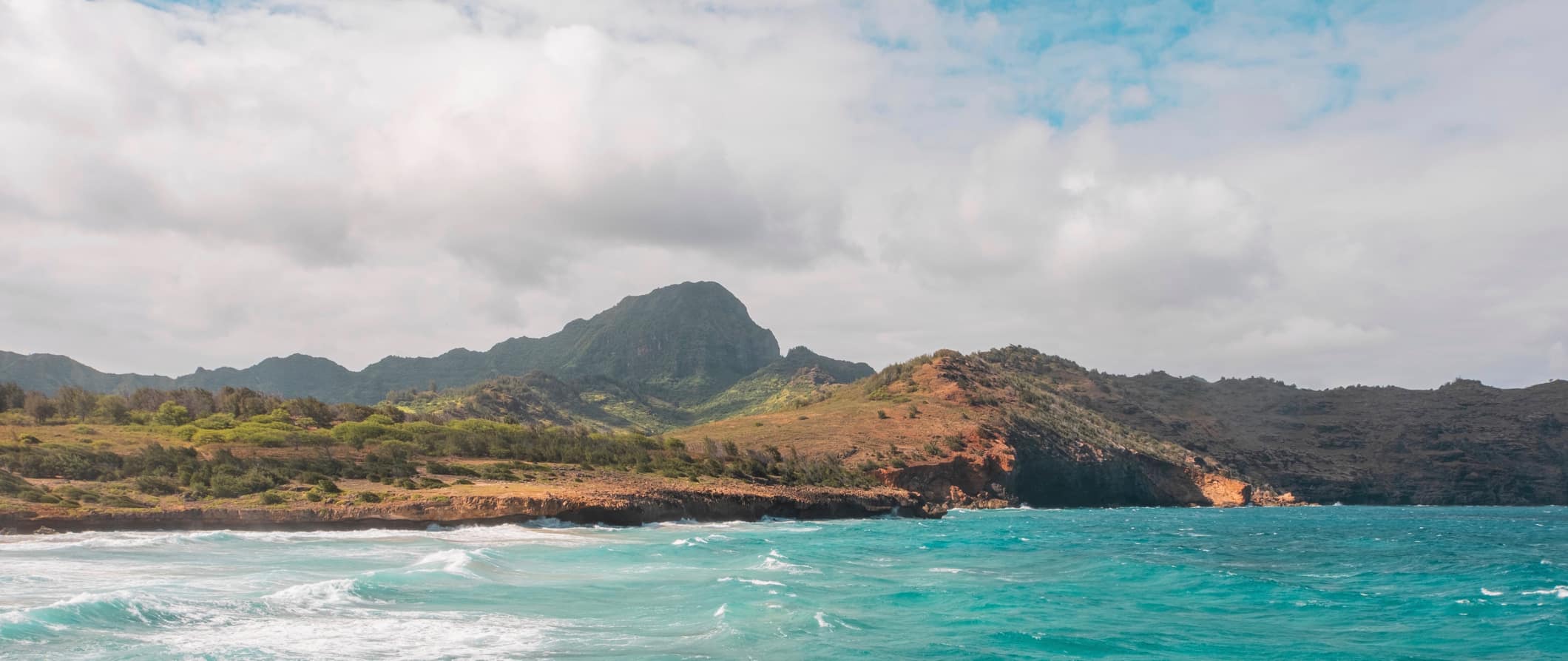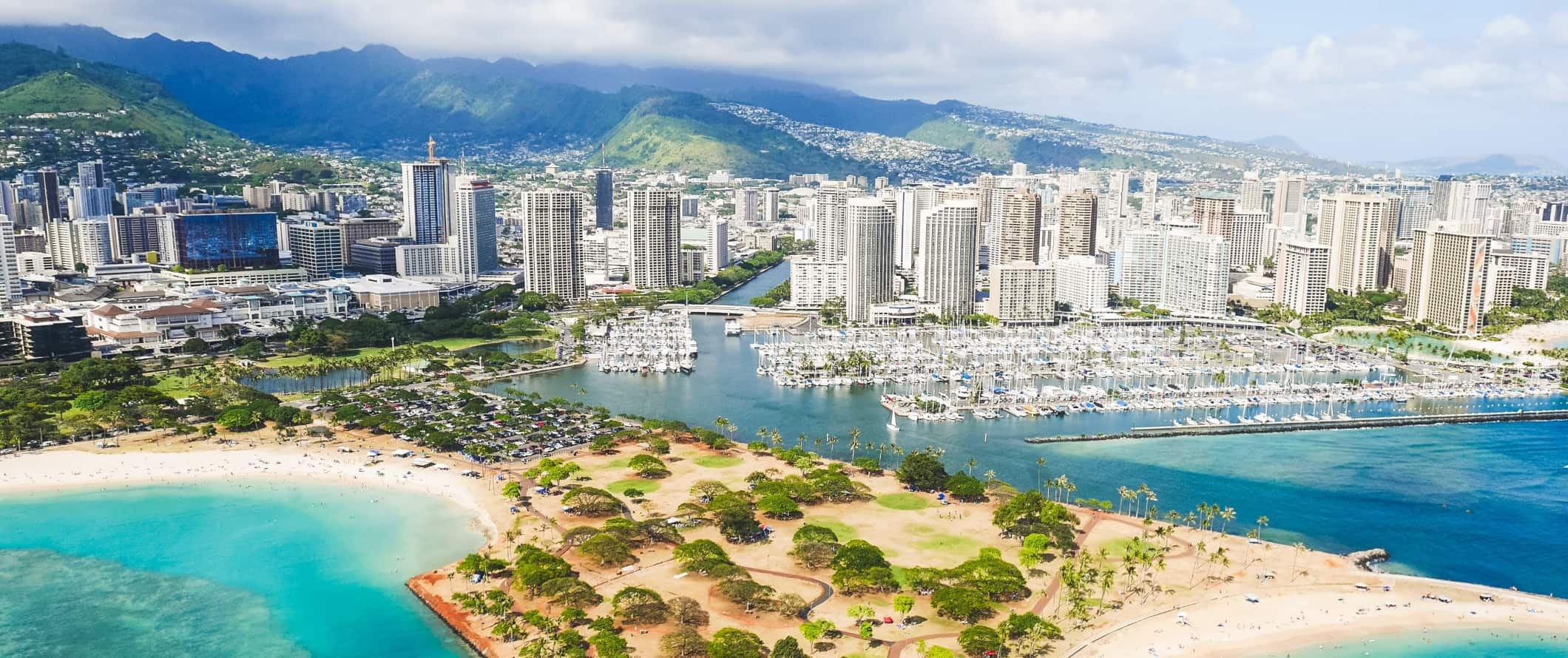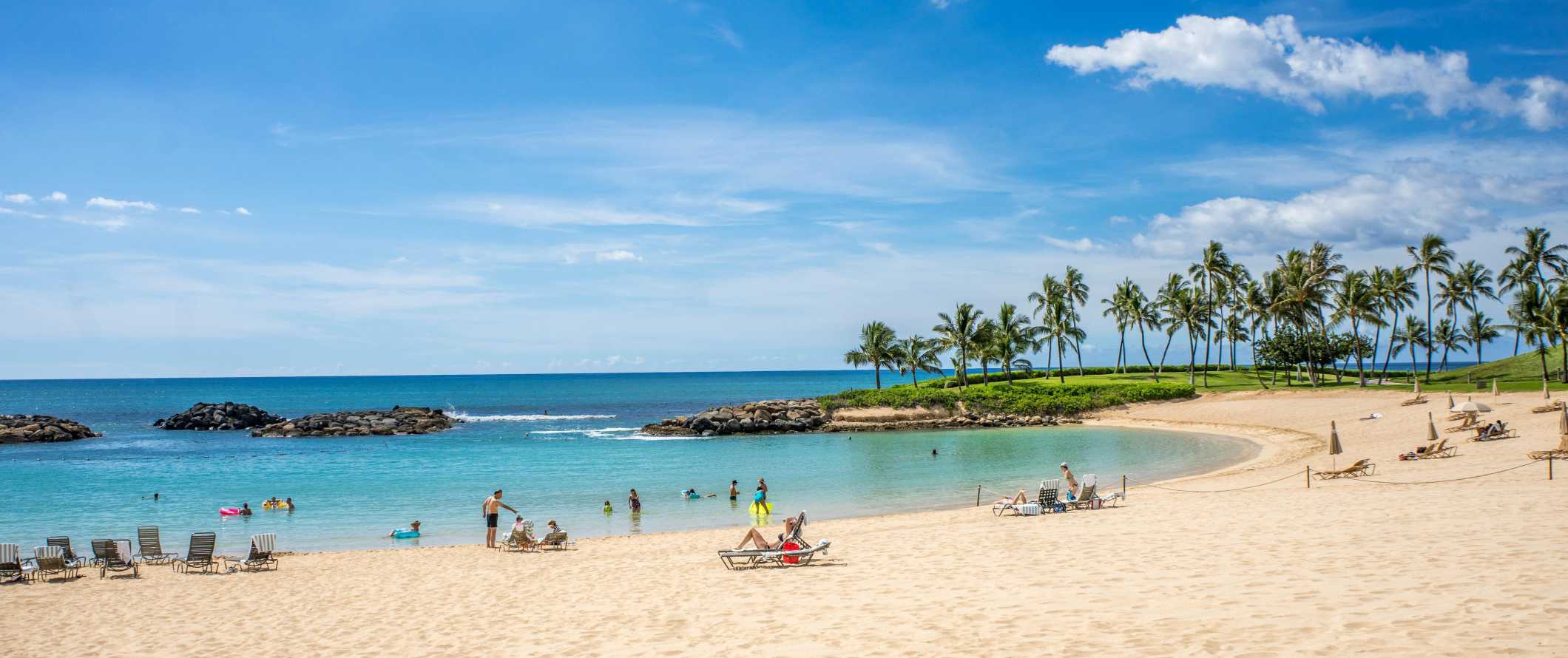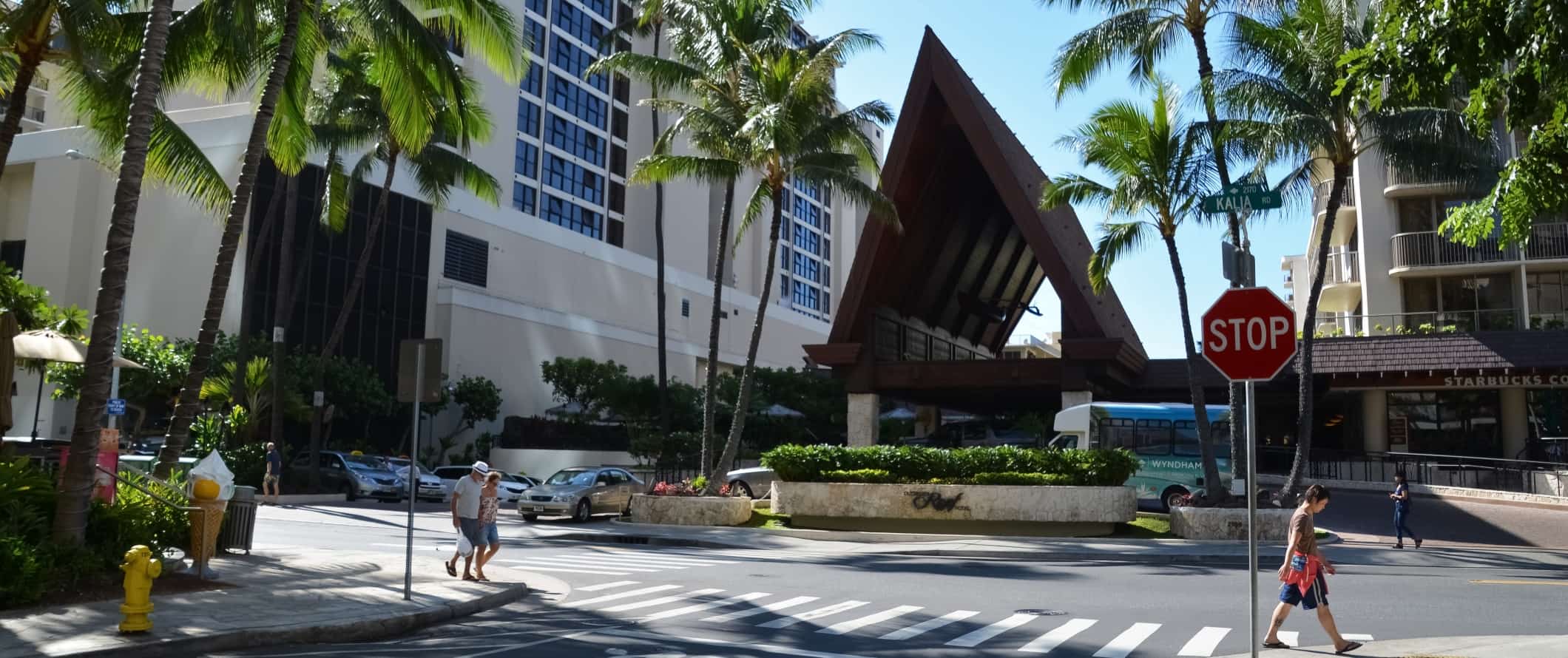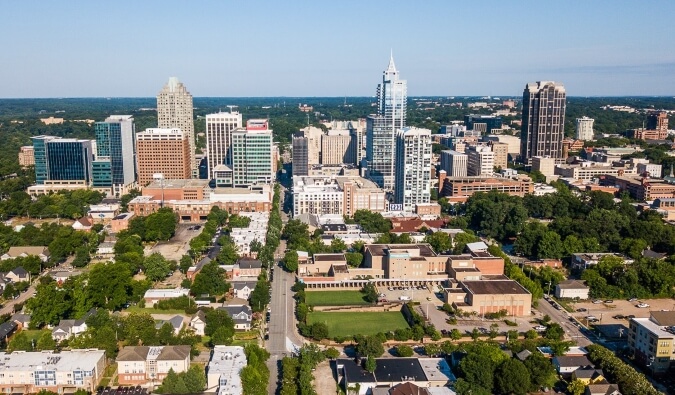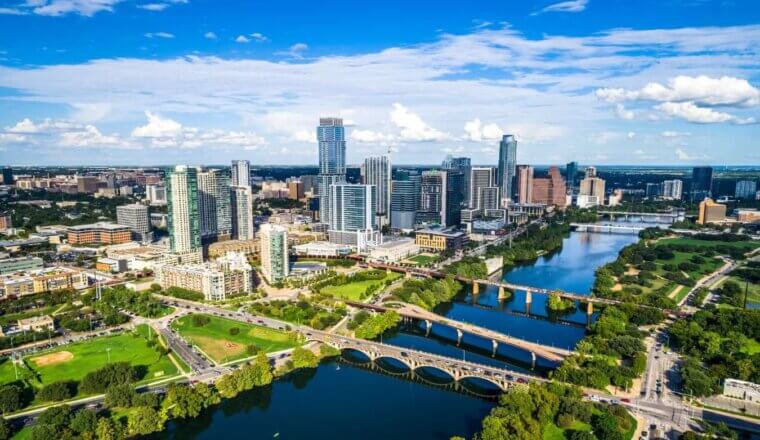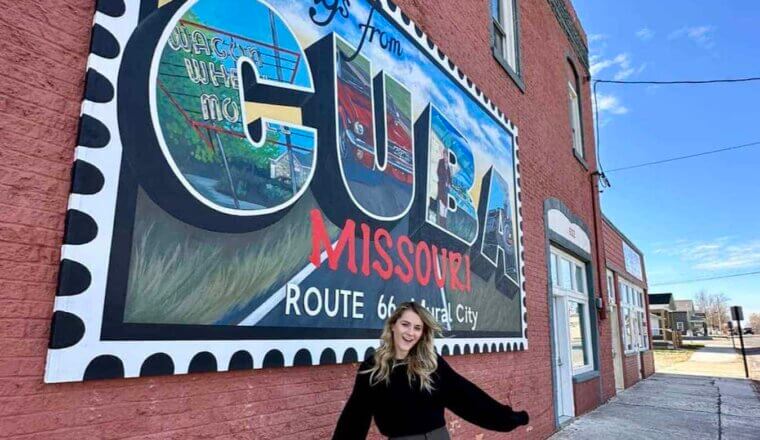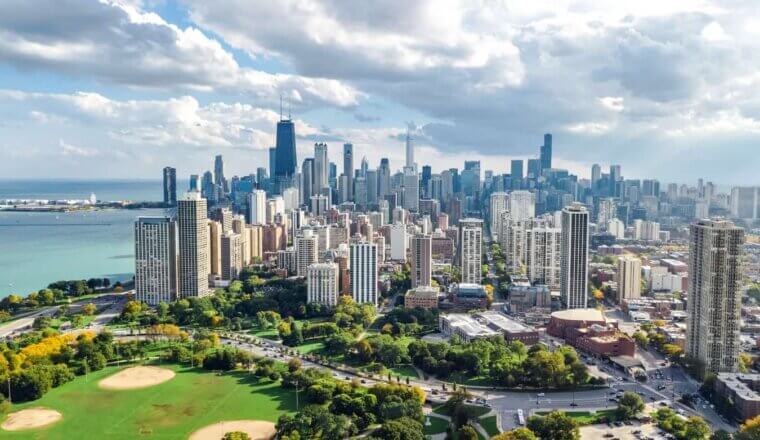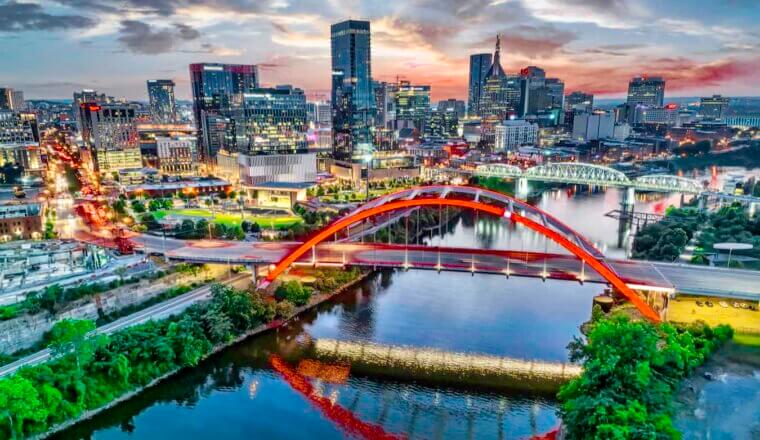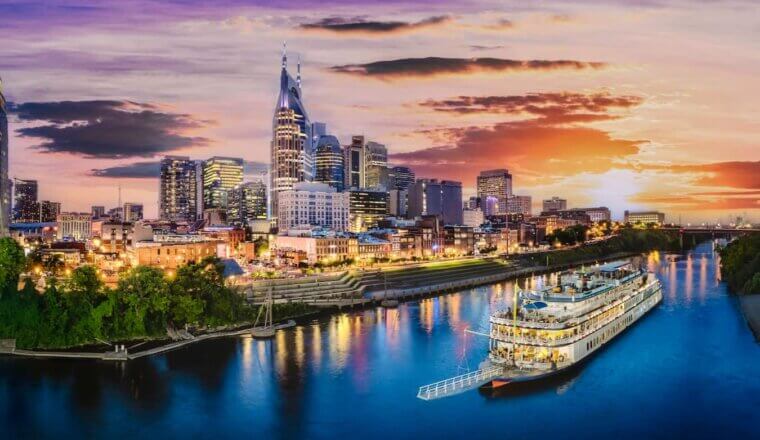Hawai’i is a post-card-perfect group of islands located 2,500 miles off the west coast of mainland USA.
It’s a popular getaway for surfers, honeymooners, hikers, and anyone looking to slow down and enjoy the slower pace of island life. The beauty of Hawai’i lies in the land (or Aina), people, and indigenous culture. As a visitor, it’s essential to understand Hawai’i’s complex and painful history and, as with all places, treat this place with an abundance of respect.
With several islands to choose from, Hawai’i has something for every traveler. From the surfing on O’ahu, to the wonders of Maui, to the beauty of Honolulu, to the hidden gems on Lana’i, Hawai’i is a boundless tropical escape. There are beautiful beaches, amazing jungles, stunning waterfalls, excellent diving, and world-class waves.
I love the relaxed atmosphere, the fresh tropical fruit and delicious seafood, and the endless supply of outdoor activities. Hawai’i is the paradise you think it will be. Owing to its Asian and Polynesian roots, Hawai’i offers an intriguing balance of feeling like you’re in a foreign land while also being in the United States. It’s a balance between the three that makes Hawai’i feel like a cultural waystation.
This travel guide to Hawai’i can help you plan an affordable and enjoyable trip — no matter what island you choose!
Table of Contents
Top 5 Things to See and Do in Hawai’i
1. Visit Pearl Harbor
The Japanese attack on the American navy in Pearl Harbor brought the United States into World War II in 1941. The Pearl Harbor National Memorial on O’ahu is centered around the wreckage of the USS Arizona, the bombed ship that marks the resting place of 1,102 marines and sailors. To see the sunken ship and visit the memorial built over top of it, you’ll need to take a ferry that’s free but requires advance reservations. Book these early as they fill up fast and lines for a day-of ticket can be hours long. Admission to the entire site is free.
2. Explore Hawai’i Volcanoes National Park
The Big Island is home to two of the world’s largest volcanoes, including the very active Kilauea. It’s one of the most active volcanoes on Earth, and you can see its glow at night from the Halema’umau crater. Don’t miss the Thurston lava tube (a cave formed by lava that you can explore) near the parking lot. The Chain of Craters is a scenic drive as it passes by several historic and active eruption sites. Just be sure to check the daily report on the condition of the road beforehand as it is frequently covered in ash. The national park is a UNESCO World Heritage Site and International Biosphere Reserve in recognition of its unique natural value. Admission is $30 USD per vehicle, which gives you access to the park for 7 days.
3. Explore Honolulu
Honolulu, which means “sheltered harbor” in Hawaiian, is the state’s capital and largest city. It offers a unique blend of Asian, Hawaiian, and American cultures, making it a great foodie city, with tons of cheap noodle joints and fresh seafood places. If you’re in town for First Friday (the first Friday of the month), you can join one of the many street parties. While based in Honolulu, hike Diamond Head, visit the historic Iolani Palace, stroll the cool Kaka’ako district, and hang out on the beach. Just avoid Waikiki, where the beach is man-made and the tourist crowds are overwhelming.
4. Stargaze at Mauna Kea
This dormant volcano is Hawai’i’s highest peak at 13,796 feet (4,207 meters) and a sacred site for native Hawaiians. It is over 1 million years old, and last erupted 4,000-6,000 years ago. Mauna Kea boasts a number of observatory domes that are home to the greatest collection of telescopes in the world (they’re not open to visitors though). Instead, stop at the visitor center to stargaze through the telescopes there or attend a free stargazing session (currently suspended due to COVID-19). If you want to reach the summit, you must either rent a vehicle with 4WD or join a tour.
5. Go snorkeling or diving
A trip to Hawai’i is not complete without snorkeling or scuba diving. Get a chance to glimpse incredible wildlife, from manta rays to sea turtles to colorful schools of fish, all while swimming through the crystal clear ocean. Kealakekua Bay, Poipu Beach Park, and the North Shore are some popular spots for snorkeling while Kailua-Kona, Golden Arches, and The Cathedrals are some of the best dive sites. Snorkel tours start at $85 USD while two-tank dives start at $125 USD.
Other Things to See and Do in Hawai’i
1. Explore the Waipi’o Valley
The lush wilderness of the Waipi’o Valley (Big Island) was once home to Hawaiian kings. Today, it’s covered with taro fields. Waipi’o is named for the river that cuts between the valley walls, giving way to waterfalls until eventually flowing into the ocean at a black sand beach. There are many trails here, but the main hike down into the valley takes you to the black sand beach and back up again. It’s 6.5 miles (10 kilometers) and strenuous but worth it.
2. Night dive with manta rays
On Big Island, take a sunset cruise along the Kona coast to the Manta Ray Village. Here, you can swim with giant manta rays — some of which measure 18 feet (5.5 meters) in length and weigh up to 1,600 pounds (725 kilograms)! It’s one of the best spots in the world to swim with mantas. The manta rays feed off the phytoplankton and zooplankton, and they appear to glow underwater due to bioluminescence. Snorkel tours start at $125 USD while single-tank night dives start at $149 USD.
3. Go on a helicopter tour
For a birds-eye view of the islands in all their scenic beauty, take a helicopter tour. Fly over the lush rainforests and stark volcanic landscapes and admire the turquoise ocean from above. They aren’t cheap but they make for a fun once-in-a-lifetime experience to splash out on. Rides are usually 45-60 minutes long and focus on a single island. Kaua’i, O’ahu, and Big Island all have incredible scenery to soak up. Helicopter tour prices start at $325 USD per person. Paradise Helicopters and Blue Hawaiian are two of the biggest and longest-running tour operators. You can also do a scenic flightin a small plane with AirVentures for $169 USD.
4. Attend a Kaanapali Sunset Luau
A luau is a traditional Hawaiian party or feast that is usually accompanied by entertainment. Until 1819, luaus were separated by gender; men and women would eat separately. At the Kaanapali Luau, there’s a traditional Hawaiian dance ceremony, a Samoan fire dance, and a traditional Hawaiian buffet — most of which is cooked in an underground oven. You’ll have a sunset backdrop on the beach throughout the whole thing too. Prices start at $125 USD.
5. Hike the Waimea Canyon and Napali Coast
If you want to see why they call Kaua’i “The Garden Isle,” hike one of the many trails along the west side of the island. The trails are well marked and offer spectacular views of the canyon and coast as well as interesting tropical plants. You can do longer multi-day treks here as well. The Kalalau Trail is considered the most beautiful hike in Hawai’i, with 22 miles (35 kilometers) of trails across valleys, streams, and coastline. To do the entire trail, you’ll need to apply for a camping permit for a multi-day trip. Permits are $35 USD per person per day. Only 60 permits are given out per day and they get snatched up fast (reservations go up 90 days in advance). You can also get a day-use pass which grants you access to a 6-hour time slot ($10 per timeslot plus $5 entry/person, with limited parking available). If that’s sold out, you have to take the shuttle which costs $35 USD but includes entry.
6. Check out the Bishop Museum
The Bishop Museum on O’ahu is a Polynesian anthropological institute that showcases Hawai’i’s cultural art and artifacts. It’s the largest museum in Hawai’i and home to the world’s largest collection of Polynesian artifacts. The Hawaiian Hall is its main gallery, covering Hawaiian mythology (it has a stunning interior with beautiful wooden architecture). There’s also a science center for children. Built in 1889, the museum is on the U.S. National Register of Historic Places. Admission is $26.95 USD during the week and 28.95 USD on the weekend.
7. Go river tubing
On Kaua’i, you can go backcountry river-tubing. You’ll drive through abandoned sugar cane plantations and then float down a series of canals in an old irrigation system from the 19th century. As you travel down the river, you pass through dark tunnels and lush rainforest landscapes. Kaua’i Backcountry Tours start from $149 USD and last around three hours. Drinks and lunch are included.
8. Drive the scenic road to Hana
If you’re on Maui, driving the winding road to Hana is a must. It’s a twisty, hairpin-turn journey along the coast with lots of scenic viewpoints and waterfalls. Make sure you stop at the Oheo Gulch and spend time hiking the Pipiwai Trail to the 400-foot (121-meter) Waimoku Falls. It’s just a four-mile (6.5-kilometer) trek and you get to see some massive banyan trees along the way. For another scenic drive, check out the Kahekili Highway. It’s less busy, has hairpin turns, and has plenty of sights to see too (such as the Nakalele Blowhole).
9. Tour a coffee plantation
Hawai’i is one of the few places in the USA where coffee is grown. For an in-depth coffee plantation tour, head to the Kuaiwi Farm in Kona on Big Island. You’ll learn all about the coffee process from beginning to end, as well as how a variety of other organic staples are grown, including cacao, pineapples, and bananas. Tours are $35 USD and include samples. They also offer a chocolate-making class for $85 USD.
10. Learn to surf
Surfing is huge in Hawai’i. O’ahu North Shore is especially popular with surfers of all levels and major competitions are often held here. If you want to learn how to surf, sign up for some classes (or even a multi-day surf camp). Group classes are generally around $100 USD. North Shore O’ahu Surf School has some great instructors and offers private classes for $200 for a two-hour lesson. You can find surfboard rentals around the islands for around $25-35 USD per day or $100-130 USD per week.
11. See the sunrise at Haleakala
Haleakala is a 10,023-foot (3,055-meter) dormant volcano on Maui offering one of the most spectacular sunrises you’ll ever see. It’s really, really cold at the top (bring gloves and a hat) and the drive up is precarious but the views over Maui at the top are worth it. You can also do the challenging 12-mile (19-kilometer) volcano hike across flower farms, pine forests, and pebbly volcanic landscapes. It’s super easy to do on your own, however, tours are also available (they last 9 hours and start at $220 USD). If you’re traveling from the mainland, do this on one of your first days as your jetlag will work in your favor so you can wake up early with ease.
12. Hike Diamond Head
Located on the eastern end of Waikiki, Diamond Head is O’ahu’s most famous landmark. This dormant volcano and its extinct crater were created during a volcanic eruption over 300,000 years ago. You can hike to the scenic lookout point at the top for panoramic views over Honolulu. The trail is just .8 miles (1.2 kilometers) long, but it’s incredibly steep, so wear your most comfortable shoes. The hike is so popular that you’ll want to start as early in the morning as possible (before the busloads of tourists show up). It’s just $5 USD to visit and parking is $10 USD per vehicle, but you must make reservations (you can reserve up to 14 days in advance).
13. Hike the Ka’iwa Ridge
This hike is better known as the Lanikai Pillbox Trail because you’ll hike by military observation stations from the 1940s (they’re not actually pillboxes as they were never used for defensive purposes). It’s a moderately steep, 1.8-mile (2.9-kilometer) hike that takes you to the ridge overlooking the crystal blue waters of Lanikai and Kailua beaches. There’s no shade so it’s best to do this hike in the early morning or late afternoon. While Diamond Head may be more convenient if you’re staying in Waikiki, the drive out to this hike is well worth it.
14. Hit the beach
It’s hard to find a bad beach to hang out on in Hawai’i. Most of them have powder-white sands, swaying palm trees, and epic sunsets. Check out Papakolea Beach/Green Sand Beach (Big Island), Kailua Beach (O’ahu), Ala Moana Beach Park (O’ahu), Makena Beach (Maui), Hanalei Beach (Kaua’i), Polihua Beach (Lana’i), and Kaanapali Beach (Maui), to name a few. There’s so much stunning coastline in Hawai’i and you can often just pull your car over and relax on any random beach without it getting too overcrowded.
15. See Hilo
Hilo is the busiest town on Big Island and its historic downtown area is chock full of galleries, museums, shops, and restaurants. One of its must-see highlights is the Farmer’s Market, which is open seven days a week but there are especially large markets every Wednesday and Saturday. You’ll find everything from fresh fruit to smoothies to handmade jewelry here, and there are often musicians and street performers too. Be sure to walk around the Liliuokalani Gardens and enjoy its Japanese rock gardens and pagodas (admission is free). Also, don’t miss Two Ladies Kitchen, which has some of the best and freshest mochi (Japanese rice cake) you’ll find outside of Japan.
16. Explore Lana’i
Known as Pineapple Island, Lana’i is the 6th smallest island in Hawai’i. It’s also the smallest publicly accessible inhabited island too (just over 3,000 people live here). The island is a 45-minute ferry from Maui and is home to beautiful beaches, scenic nature trails (Munro and Naha are two popular trails), and a couple of golf courses. It’s a relaxing place to get away for a day or two if you want to avoid the crowds. Consider renting a 4×4 jeep or hiking the Kealia Kapu-Kaunolu Village Heritage Trail. If you’re visiting on a day trip, take the first ferry in and the last one out to maximize your time.
17. Visit Moloka’i
This is the 5th smallest island and arguably the “most” Hawai’ian as it’s home to the highest number of native Hawai’ians per capita. With only 8,000 people here, it has a very rural feel and is very different from the tourist hubs of the larger islands. Located just north of Maui, it’s a good place to visit if you want to get a feel for the quiet life in Hawai’i. Don’t miss Kepuhi Beach, a popular spot to swim and surf.
For more information on other destinations in the United States, check out these guides:
Hawai’i Travel Costs
Hostel and camping prices – A bed in a 4-6-bed dorm costs $50-70 USD per night. For a room with 8 beds or more, expect to pay around $30-45 USD. Private rooms with a shared bathroom cost $80-100 USD per night. Free Wi-Fi is standard and many hostels also include free breakfast, free shuttles to the beach, and free tours. Prices don’t vary much throughout the year.
Hawai’i also has lots of campgrounds. To stay at any of Hawai’i’s state parks (camping.ehawaii.gov), apply for a permit ($30 USD per night for non-residents for a campsite that can accommodate 4 people) at least a month in advance. Otherwise, you might not get a spot.
You can also find private campgrounds for as little as $10 USD per person. Some people recommend wild camping on beaches for free, but this isn’t actually allowed in most places due to the delicate environment. Plus, it’s too easy to wander onto sacred grounds, which is a big no-no.
Budget hotel prices – Hotel prices vary depending on where you are. Expect higher prices in the more touristy areas of Hawai’i, especially along Waikiki Beach and around Maui. Nightly rates for a budget two-star hotel room start at about $200-300 USD for places in Waikiki and Maui and $150-175 USD if you stick to the less touristy areas.
There are lots of Airbnb options around Hawai’i. Private rooms start at $75-90 USD per night while an entire home or apartment start at $125-200 USD per night. Expect to pay double if you don’t book well in advance.
Note: There are strict laws around short-term rentals in Hawai’i and each island has its own rules. Be mindful of this when booking.
Food – Hawai’ian food is a mix of Polynesian and mainland US influences, with other Asian influences (especially Japanese) thrown into the mix as well. Seafood is the main staple, with tuna, mahi-mahi, and wahoo being some of the most popular offerings. Pork and chicken are common as well (especially Kalua pig, which is slow-roasted pork cooked underground).
Poke (diced or cubed raw fish) is one of the most popular dishes as it mixes well with all kinds of fresh salads. Of course, you can also find numerous Spam dishes here as well. Spam was served to soldiers in World War II, owing to its long shelf life and the fact it didn’t need to be refrigerated. It evolved into a cultural staple from there.
For food on the go, hot dogs cost around $4 USD. A meal of poke or a hearty salad from a deli costs about $11 USD while a half-chicken is $10 USD. A classic Spam musubi starts at $3 USD. Drop by a 7-11 for a similar experience to a Japanese konbini with Hawai’ian delicacies.
You can find plates of chicken, rice, and salad (what locals call a “plate lunch”) for $10-15 USD. A big plate of garlic shrimp costs $12 USD. Vegetarian dishes cost about the same. Buffets on the islands start at $25 USD.
Fast food (think McDonald’s) costs $9.50 USD for a combo meal. A piña colada or wine costs $10-15 USD while a beer costs $7-10 USD. For a latte or cappuccino, expect to pay around $5.50 USD. Bottled water costs $2 USD.
At a typical sit-down restaurant serving Hawai’ian food, a main course starts at $30 USD for seafood or steak while pasta or vegetarian is only slightly cheaper at $20 USD for a dish. Burgers are $16-19 USD and soup and salad starters are about $12 USD.
A main dish at a Chinese takeout restaurant costs $12-14 USD while the same at a Thai place costs $15-17 USD.
If you have a bigger budget, a whole prix-fixe menu with three courses costs at least $50 USD, while a luau costs between $50-150 USD.
If you cook your own food, expect to pay $75-80 USD per week for groceries that include pasta, vegetables, chicken, and other basic staples. You can save money if you shop at discount stores such as Cost-U-Less (Big Island and Kaua’i), Don Quijote (O’ahu), and Big Save (Kaua’i), which offer reasonable prices for food and alcohol.
Backpacking Hawai’i Suggested Budgets
If you’re backpacking Hawai’i, plan on spending around $85 USD per day. On this budget, you can stay in a hostel dorm, cook all of your meals, do free activities like hiking and walking tours, limit your drinking, and take public transportation to get around.
On a mid-range budget of $255 USD per day, you can stay in a private hostel room or Airbnb, eat out for most meals out at inexpensive restaurants serving traditional cuisine, do some surfing or diving, have a few drinks at the bar, and take the occasional taxi.
On a “luxury” budget of $4890 USD per day, you can stay in a hotel, eat out at nicer restaurants and have some drinks, take private guided tours, snorkel or dive, rent a car to get around, and do as many activities and excursions as you want. This is just the ground floor for luxury though. The sky is the limit!
Hawai’i Travel Guide: Money-Saving Tips
Hawai’i is expensive. It’s a tourism hotspot, most of its food is imported, and there’s a LOT to see and do. But if you want to lower your costs, here are some ways to save money in Hawai’i:
- Stay at Maui’s Banana Bungalow for free tours – The Banana Bungalow on Maui runs daily free tours, covering most of the island’s highlights. Cut costs by staying here.
- Travel off-season – Traveling during low seasons (mid-April to mid-June and mid-September to mid-December) can save you money on lodging.
- Buy local – Due to high import costs, many products and groceries can be expensive. Instead, take advantage of the plethora of local produce and goods. A great way to find them is at farmers’ markets all across the islands. Not only do they sell fresh produce to cook at your hostel, but many local food purveyors also set up shop so you can stock up on pre-made meals. Check these websites for different market options.
- Visit the discount groceries – Discount stores such as Cost-U-Less (Big Island and Kaua’i), Don Quijote (O’ahu) and Big Save (Kaua’i) offer inexpensive food and alcohol. Note that locally-grown produce is significantly cheaper than imported stuff, so stock up on local food as much as possible.
- Redeem hotel points – Be sure to sign up for hotel credit cards before you go and use those points when you travel. Many of the nice resorts here are owned by big hotel chains where you can stay for free with points.
- Stay with a local – If you’re on a tight budget, stay with a local via Couchsurfing. You’ll not only get free accommodation but you’ll get access to an insider who can share their tips and advice with you.
- Rent a bike – If you’re on O’ahu, download the Biki app to access the island’s bike-sharing platform. Single rides start at $4.50 USD, a one-day pass with unlimited 30-minute rides is $12 USD, and a 300-minute pass is $30 USD.
- Be smart with your car rental – If you want to rent a car just for a few hours, the Hui Car Share app has vehicles available in many tourist hot spots for an hourly rate. It may be cheaper than a full-day rental depending on your needs. Prices start at $12 USD per hour or $125 USD per day, which includes gas.
- Skip the taxis – Uber and Lyft are cheaper than taxis and are the best way to get around a city if you don’t want to take a bus or pay for a taxi. The shared/pool option (where you share a ride with other people) offers even better savings.
- Get a Go Oahu pass – This discount pass offers discounts to over 40 O’ahu attractions. Passes are available from 1-7 days, starting at $84 USD for a one-day pass.
- Take a free walking tour – I love free walking tours. They’re a great way to get oriented and see the major sights without breaking the bank. Try the tour of Honolulu with Hawaii Free Tours (currently suspended due to COVID-19). Just be sure to tip your guide at the end!
- Bring a reusable water bottle – The tap water here is generally safe to drink so skip the bottled water. You’ll save money and reduce your environmental footprint. LifeStraw makes a reusable bottle with a built-in filter that ensures your water is always clean.
Where to Stay in Hawai’i
Hawai’i has lots of hostels. Here are my recommended places to stay in Hawai’i:
- The Beach Boutique Hostel (O’ahu)
- Banana Bungalow (Maui)
- Aloha Surf Hostel (Maui)
- My Hawaiian Hostel (Big Island)
- Pineapple Park (Big Island)
- Hilo Bay Hostel (Big Island)
How to Get Around Hawai’i
How you get around Hawai’i depends on which islands you’re visiting. Some islands (like Maui and O’ahu) have better infrastructure for getting around compared to places like Kaua’i.
Bus – Buses are the only public transportation option in Hawai’i (though Lana’i and Moloka’i do not have buses). O’ahu has the most extensive transit system, with decent coverage and frequent buses. It’s simply called The Bus, and a single ride fare is $3 USD, which includes 2.5 hours of unlimited free transfers.
Your daily fare will be capped at $7.50 USD providing you have a HOLO Card, which you can get for a one-time fee of $2 USD at transit centers, supermarkets, and convenience stores around the island. The bus company’s official website is terrible for trip planning so you’re better off using Google Maps.
Maui Bus, Kauai Bus, and Hele-On Bus (Big Island) also operate island-wide, with prices starting at $2 USD and daily passes costing $4-5 USD. Again, none of these websites are very user-friendly so use Google Maps to plot your route.
Flying – Flying is the main (and often only) way to travel between the islands. Flights are generally cheap, quick, and super casual (most of the time, you don’t even get assigned seats). Hawai’i’s domestic airlines are Hawaiian Airlines and Mokulele Airlines. Southwest also has some flights between islands as well.
Flights are generally affordable. For example, one-way flights from Maui to Honolulu cost around $40-50 USD while Kaui to Maui is $40-75 USD. Honolulu to Hilo (Big Island) is also $40-50 USD.
Car Rental – While not usually the cheapest option, having a car in Hawai’i is the best way to get around. Prices start from about $50 USD per day (if you rent for a week or more). For shorter rentals, expect to pay $65 USD or more per day. For the best rental car deals, use Discover Cars.
Ferry – You can only take a ferry between Maui and Lana’i. Everywhere else, you’ll need to fly. The ferry is about $30 USD each way. You can reserve a ticket on go-lanai.com.
Taxis – Taxis are expensive. Everything is meter-based and starts around $3.50 USD and then costs an additional $3 USD per mile. Skip the taxis if you can!
Ridesharing – Uber and Lyft are cheaper than taxis and are the best way to get around a city if you don’t want to take a bus or pay for a taxi. They’re available on most of the islands.
Hitchhiking – This is one of the easiest places to hitchhike in the US. For tips and info, check out Hitchwiki. It’s the best hitchhiking resource.
When to Go to Hawai’i
Peak season in Hawai’i starts in the middle of December and lasts until the end of March/mid-April, as that is when mainland Americans are trying to escape the colder winter months. The average daily temperature during this time is 78°F (26°C).
Traveling during low seasons (mid-April to mid-June/mid-September to mid-December) offers nice weather and fewer crowds (and slightly cheaper prices). The average daytime summer temperature is 85°F (29°C).
It’s always hot and sunny here so there’s never really a bad time to visit!
How to Stay Safe in Hawai’i
Hawai’i is a safe place to visit. Violent attacks are rare and tend to be confined to certain areas of Honolulu (specifically where drug and gang violence are a problem). As a general rule, however, avoid walking alone late at night in the city.
You may encounter petty crime, like theft, so keep your valuables secure. The islands are notorious for car break-ins so make sure yours is always locked. Never leave any valuables in your vehicle overnight.
Heed any warnings or alerts about severe weather or volcanic eruptions (although they’re rare). Always check the weather before you go hiking.
If you’re not a strong swimmer, stay out of the ocean. NEVER swim alone — the rip tides here are strong.
Above all: respect the land. Much of Hawai’i is considered sacred. You will show enormous disrespect if you trespass onto any sacred, private property, or litter anywhere on the islands. Do NOT do it.
Bring a refillable water bottle and skip single-use plastics like straws and cutlery. Plastic bags are banned so be sure to bring a reusable tote for groceries or shopping.
Lastly, the Hawaiian sun can be very intense so respect it and your skin by making sure you wear ample sunscreen. All sunscreen must be reef safe to protect the habitat. This local brand works well and is safe for kids too.
If you experience an emergency, dial 911 for assistance.
Always trust your gut instinct. Make copies of your personal documents, including your passport and ID. Forward your itinerary along to loved ones, so they’ll know where you are.
The most important piece of advice I can offer is to purchase good travel insurance. Travel insurance protects you against illness, injury, theft, and cancellations. It’s comprehensive protection in case anything goes wrong. I never go on a trip without it as I’ve had to use it many times in the past. You can use the widget below to find the policy right for you:
Hawaii Travel Guide: The Best Booking Resources
These are my favorite companies to use when I travel. They consistently have the best deals, offer world-class customer service and great value, and overall, are better than their competitors. They are the companies I use the most and are always the starting point in my search for travel deals.
- Skyscanner – Skyscanner is my favorite flight search engine. They search small websites and budget airlines that larger search sites tend to miss. They are hands down the number one place to start.
- Hostelworld – This is the best hostel accommodation site out there with the largest inventory, best search interface, and widest availability.
- Booking.com – The best all around booking site that constantly provides the cheapest and lowest rates. They have the widest selection of budget accommodation. In all my tests, they’ve always had the cheapest rates out of all the booking websites.
- Get Your Guide – Get Your Guide is a huge online marketplace for tours and excursions. They have tons of tour options available in cities all around the world, including everything from cooking classes, walking tours, street art lessons, and more!
- SafetyWing – Safety Wing offers convenient and affordable plans tailored to digital nomads and long-term travelers. They have cheap monthly plans, great customer service, and an easy-to-use claims process that makes it perfect for those on the road.
- LifeStraw – My go-to company for reusable water bottles with built-in filters so you can ensure your drinking water is always clean and safe.
- Unbound Merino – They make lightweight, durable, easy-to-clean travel clothing.
- Top Travel Credit Cards – Points are the best way to cut down travel expenses. Here’s my favorite point earning credit cards so you can get free travel!
Hawai’i Travel Guide: Related Articles
Want more info? Check out all the articles I’ve written on United States travel and continue planning your trip:
